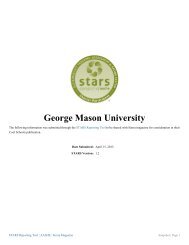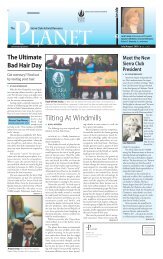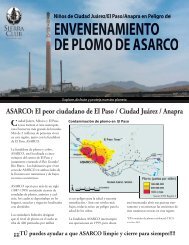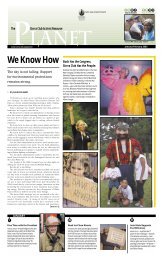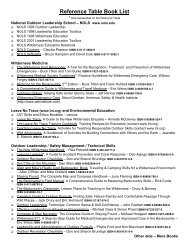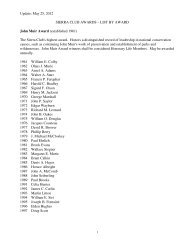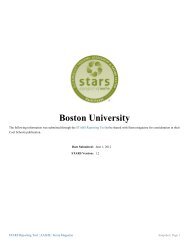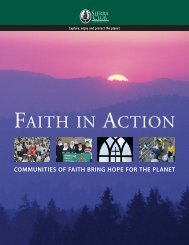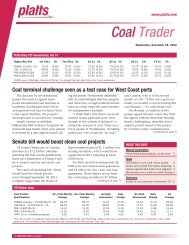Toxic Tar Sands: Profiles from the Front Lines - Sierra Club
Toxic Tar Sands: Profiles from the Front Lines - Sierra Club
Toxic Tar Sands: Profiles from the Front Lines - Sierra Club
You also want an ePaper? Increase the reach of your titles
YUMPU automatically turns print PDFs into web optimized ePapers that Google loves.
THE HEART OF THE TAR SANDS:<br />
A BligHt on nAtiVe coMMUnities<br />
people Are dying,” says George Poitras, a<br />
“My member of <strong>the</strong> Mikisew Cree First Nation in Fort<br />
Chipewyan, Alberta. His community, situated just downstream<br />
<strong>from</strong> <strong>the</strong> vast toxic moonscape of tar sands development in Alberta,<br />
has absorbed some of <strong>the</strong> worst damage <strong>from</strong> <strong>the</strong> project.<br />
“The extraction of oil <strong>from</strong> Canada’s tar sands is having a<br />
devastating impact on our indigenous people,” Poitras says.<br />
Studies have found levels of mercury, arsenic, lead, and o<strong>the</strong>r<br />
toxins at elevated levels near <strong>the</strong> area’s tar sands excavation sites. 5<br />
These chemicals are known carcinogens and cause <strong>the</strong> types of rare<br />
cancers—including cancer of <strong>the</strong> bile ducts—that are on <strong>the</strong> rise<br />
among members of <strong>the</strong> Fort Chipewyan community.<br />
Statistically, bile duct cancer normally occurs in one out of<br />
every 100,000 people. But a study by <strong>the</strong> Alberta Cancer Board<br />
confirmed <strong>the</strong>se cancer rates at Fort Chipewyan are 30 percent<br />
higher than average. 6<br />
Poitras has been on a mission to raise awareness about <strong>the</strong> harmful<br />
effects of tar sands development on his community’s health—ever<br />
since 2006, when Fort Chipewyan’s general physician, Dr. John<br />
O’Connor, went public in <strong>the</strong> press about <strong>the</strong> unusual cancers<br />
among <strong>the</strong> patients he served.<br />
4 TOXIC TAR SANDS: PROFILES FROM THE FRONT LINES<br />
<strong>Tar</strong> SandS are deSTruCTive aT every STage Of Their lifeCyCle, <strong>from</strong> <strong>the</strong><br />
ravaged boreal forests of Nor<strong>the</strong>rn Canada to <strong>the</strong> choked communities in refining<br />
corridors across America. But <strong>the</strong> indigenous communities living closest to <strong>the</strong> land<br />
bear special witness to its destruction. Tribes have spoken out on <strong>the</strong> toll tar sands<br />
have taken on <strong>the</strong>ir ancestral lands and <strong>the</strong> water and wildlife that supports <strong>the</strong>ir<br />
culture and community. These are <strong>the</strong> stories of prominent tribal activists and <strong>the</strong>ir<br />
struggle against <strong>the</strong> devastating tar sands.<br />
My people are dying.<br />
george poitras<br />
Mikisew Cree First Nation,<br />
Fort Chipewyan, Alberta<br />
PHoTo: GEoRGE PoITRAs<br />
For <strong>the</strong> past four years, Poitras has been spreading <strong>the</strong> word<br />
about <strong>the</strong> risks of tar sands oil at colleges and universities, public<br />
forums, and even at oil companies’ annual meetings. He and o<strong>the</strong>r<br />
indigenous activists have collaborated on documentary films about<br />
<strong>the</strong> tar sands that have been shown in film festivals around <strong>the</strong><br />
world.<br />
“The damage <strong>from</strong> <strong>the</strong> tar sands isn’t restricted to Fort Chipewyan<br />
or even to Alberta,” he says. There are pipelines that leak oil, and<br />
tar sands refining is a huge contributor to global greenhouse<br />
emissions. We call <strong>the</strong> tar sands ‘bloody oil.’”



